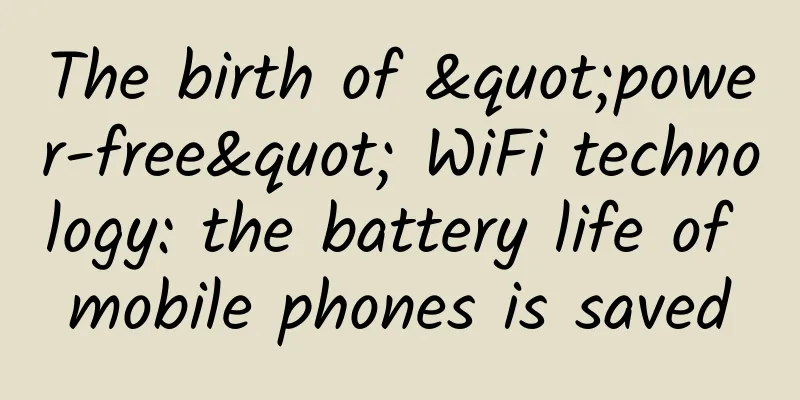The birth of "power-free" WiFi technology: the battery life of mobile phones is saved

|
Students from the School of Electrical Engineering at the University of Washington have recently developed a new Wi-Fi technology, whose greatest feature is that it consumes less than one ten-thousandth of the energy of current Wi-Fi. This technology is called "Passive Wi-Fi" and is almost the same as the routers we use today, except that it is more energy-efficient. For example, the transmission power of current routers is 100 milliwatts, while the transmission power of Passive Wi-Fi routers is only 10 to 50 microwatts, which is only one ten-thousandth of that. The new Wi-Fi technology works similarly to RFID chips, using electromagnetic back-reflection communication technology. Current Wi-Fi technology consumes electricity to provide signals; this technology is different, it selectively reflects radio waves and can also "absorb" power from radio waves. "The device using Passive Wi-Fi technology does not transmit any signal itself, it only generates Wi-Fi packets by reflection. Therefore, this is a very low energy wireless transmission technology," said Vamsi Talla, a researcher on the project. Bryce Kellogg, another researcher involved in the project, said: "It is difficult to say how much this technology will extend the battery life, because the battery life depends on many factors, such as screen brightness, but using passive Wi-Fi technology will allow the device to have almost the same battery life as when the Wi-Fi module is turned off." According to the researchers, Passive Wi-Fi works in three steps: First, a simple device needs to be installed on the wall to send analog waves to the Passive Wi-Fi sensor. Most of the power is consumed in this process, while the sensor consumes almost no power. Next, the sensor receives the analog wave and converts it into a digital form to generate a Wi-Fi data packet. Finally, the device can transmit network data to a phone or router at speeds of 11Mbps (faster than Bluetooth but slower than some home broadband). Currently, the technology has been nominated as one of the "Top Ten Technological Breakthroughs of 2016" by MIT Technology Review and has been actually applied on the campus of the University of Washington. It is reported that the technology can connect to any Wi-Fi device within 30 meters and can also penetrate walls. Best of all, each device costs less than a dollar to produce. As a winner of Toutiao's Qingyun Plan and Baijiahao's Bai+ Plan, the 2019 Baidu Digital Author of the Year, the Baijiahao's Most Popular Author in the Technology Field, the 2019 Sogou Technology and Culture Author, and the 2021 Baijiahao Quarterly Influential Creator, he has won many awards, including the 2013 Sohu Best Industry Media Person, the 2015 China New Media Entrepreneurship Competition Beijing Third Place, the 2015 Guangmang Experience Award, the 2015 China New Media Entrepreneurship Competition Finals Third Place, and the 2018 Baidu Dynamic Annual Powerful Celebrity. |
>>: The iPhone 6S only has 2GB! Is it true that more memory is better for a mobile phone?
Recommend
Jinyun palm-tipped toad! A new amphibian species discovered in Chongqing
Tadpoles are larger than adults, and frogs croak ...
Tips for Weibo promotion and traffic generation
Weibo can be said to be a big brother-level platf...
Tesla blames State Grid for new car failure, official apology: recording edited
On February 1, Tesla officially issued an apology...
Information flow advertising strategy for the legal industry!
In the past two years, many industries have faced...
Why are women shorter than men on average?
I guess everyone has noticed that regardless of e...
Three lines of underlying thinking in brand marketing
There is a clichéd saying that you and I both kno...
How much does a generator cost? How much does a household generator cost?
The prices of units of different brands and confi...
Costs are reduced by 50%, here are tips for placing OCPC information flow ads!
As the end of the year draws closer, optimizers a...
The old lady selling melons is using mobile payment. Does this hurt Apple? Cook argues that Americans love to use credit cards
Apple CEO Tim Cook recently visited Beijing and a...
What is your chance of encountering Aurora? This index is the key
Since 2019, the sun has entered its 25th activity...
The VR stage is ready and the video content warm-up match is about to begin?
VR application is not a new term for industry insi...
Does a "gluten-free diet" mean not eating whole grains? What is gluten allergy?
Audit expert: Peng Guoqiu Deputy Chief Physician,...
Ziyang Mini Program Investment Company, how much does the paper product mini program cost?
What is the investment cost of Ziyang Paper Produ...
Avoid these 5 pitfalls when placing Google ads in 2019!
When placing Google ads, we sometimes choose diff...
The traffic pool of post-90s generation is getting bigger and bigger. How can advertisers seize the traffic trend?
Recently, Dior announced its brand ambassador for...









